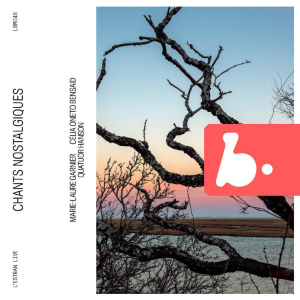
Chants nostalgiques
Gabriel FAURÉ (1845-1924)
La Bonne Chanson, Op. 61 (1892-1894)
Ernest CHAUSSON (1855-1899)
Chanson perpétuelle, Op. 37 (1898)
Poème de l’amour et de la mer, Op. 19 (1893)
Charlotte SOHY (1887-1955)
Trois chants nostalgiques, Op. 7 (1910)
Marie-Laure Garnier (soprano), Célia Oneto Bensaid (piano), Quatuor Hanson
rec. live, 31 March 2022, L’Estran, Guidel, France
Booklet with French texts and English translations
B Records LBM048 [65]
A live recording of a vocal recital might seem risky, but this disc demonstrates its virtues. There is spontaneity, a sense of commitment and communication from stage to stalls, and thus a belief in the music and texts which share the programme’s theme of nostalgic love. The theme brings together a selection of masterpieces of French song, plus one rarity worth its place alongside them. The artists gave this same programme at the Oxford Lieder Festival in the UK in October 2022. I did not hear that, so I was pleased to become acquainted with their work, especially caught on the wing.
Fauré’s La Bonne Chanson is a truly integrated song cycle. Verlaine’s poems form a group, and the composer binds them further: he favours unity over diversity with thematic relationships across the nine numbers. The poetic theme is one of untroubled happiness, though the often changing harmonies give it a restless feeling. It can be a difficult cycle for singers and for audiences. Fauré hoped the later version with piano quintet accompaniment might broaden its appeal, but he still preferred the original piano accompaniment. I took this information from Graham Johnson’s wonderful book A French Song Companion.
The performers make a fine case for the quintet version – the strings add weight to the harmonic flux and give a sensuous cushion of sound that suits the music. This is notable in the third verse of the seventh song Donc, ce sera par un clair jour d’été (So on a bright summer’s day it shall be), where the piano falls silent and only the string quartet is heard.
Soprano Marie-Laure Garnier is comfortable in her upper register but benefits from a richness in the middle and lower range more associated with mezzo-sopranos. The basic timbre is appealing, too. She has clearly mastered the right manner for this elusive cycle, flowing serenely from song to song, at times quasi-conversational, with clear diction. Sometimes her presentation of louder climactic passages approaches the operatic, even putting the tone at the top under pressure in forte moments. But this is in part a consequence of moving from a comfortable Parisian salon to the concert stage, and needing to address the rear stalls and gallery, not the microphone. In the final song L’hiver a cessé (Winter is over), which sums up all we have heard, she brings the cycle to a powerfully satisfying close.
Chausson’s Chanson perpétuelle (Endless song) to a poem by Charles Cros of thirteen three-line stanzas was first designed for soprano or mezzo-soprano and orchestra, which seems to be a rarity now. It is normally heard in the version for piano quintet, very satisfying and far from a mere reduction. Garnier savours the poem and its sad tale of a male “heart grown cold”. There is some notably passionate singing, near-Wagnerian at times; then again, Chausson was an habitué of the Bayreuth Festival. His Poème de l’amour et de la mer is best known in its orchestral guise, but Franck Villard’s transcription for piano and string quartet is very effective, and fits the rest of the programme. The instrumentalists have the central Interlude to themselves, and that allows us to hear their sensitivity and accomplishment. The fourteen-minute finale of three poems collectively called La mort de l’amour (The death of love) ends with Le temps des lilas (Lilac time) sometimes heard on its own, that takes up a theme from the Interlude. Garnier sounds particularly enamoured of Chausson’s style, and has a tender vocal manner when needed, as at the closing couplet of the cycle, “Le Temps des lilas et le temps des roses / Avec notre amour est mort à jamais” (The time for lilac and the time for roses / With our love has perished forever). Her fine mezza-voce singing is profoundly touching in capturing the mood of such lines.
Charlotte Sohy, who has been recently getting attention of recording artists, is still a rather rare contributor to the mélodie repertoire. She even managed to escape the notice of Graham Johnson’s book. The Chants nostalgiques on poems of Cyprian Halgan show she has the exact musical manner we expect of a well-schooled composer of the belle époque, with a Wagnerian touch that even outdoes Chausson in that regard. The songs, recorded for the first time in the version for piano quintet, are well worth their place here. Garnier treats them as worthy. She brings the same qualities of voice and passionate temperament to the story-telling of each poem.
There is a booklet with texts and good English translations, and an interview with Marie-Laure Garnier in a fold-out leaflet. The applause has been left in, but is fairly unobtrusive, adding to the sense of a live event before a smallish audience. The recorded sound is good, with the voice slightly forward. That might just be the skilled judgement of balance by the excellent instrumentalists, for pianist Célia Oneto Bensaid and the Quatuor Hanson play a full part in this very satisfying programme.
Roy Westbrook
Previous review: Nick Barnard (February 2023)
Help us financially by purchasing from





















